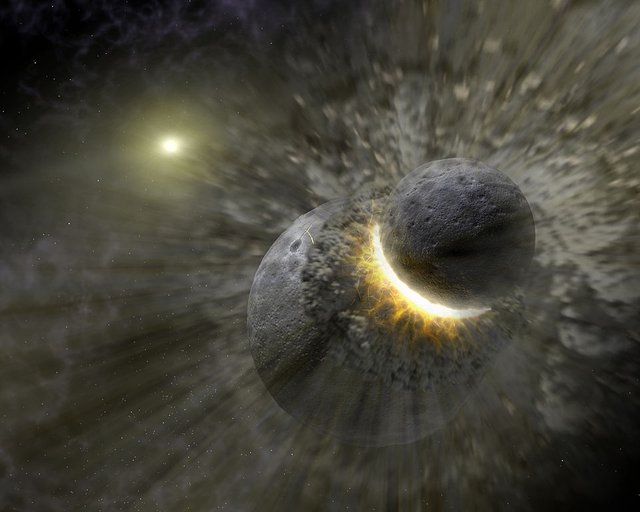Protecting Ourselves from Asteroids
Our work isn’t over when we find an asteroid heading in the direction of Earth.
We have many warning systems in place to tell us when an asteroid is heading in the direction of Earth. That isn’t enough to save us, we need a way to deflect it. There are multiple different ways to do this, kinetic impacts, a gravity tractor, an ion beam shepherd, using solar energy, a mass driver, and even conventional rockets with nukes strapped on.
Kinetic Impact
A kinetic impact involves sending a large ship into an asteroid to deflect its path. This mission would most likely be carried out with two separate ships. One a few months ahead would perform reconnaissance to measure the mass and velocity of the NEO. Once that is complete the second one would build up speed during this time, possibly using the other planets as a gravitational slingshot. It would come at an angle maximizing the difference in the velocity of the NEO and the ship and making sure it aligns with the center of mass. If the rocket doesn’t hit along the center of mass a lot of the energy will go into rotation and won’t move it off its path. [1]
Gravity Tractor
A gravity tractor would use gravity to pull a NEO out of the way. This would be done by using a high mass ship (most likely filled with space rocks) with a low power thruster. The thruster could keep it orbiting to one side of the NEO, which would pull it off course due to the gravitational attraction. This would be better than a head-on collision, because we can keep at it with the same ship until we are sure it is safe.
Other methods along these lines include using an electrostatic force between a ship and the asteroid. This force is a lot stronger than gravity, so it may be more effective. [2]
Ion Beam Shepherd
A beam of ions can be used to slowly push a NEO out of the way, from a distance. A ship capable of making a beam of ions need only be near Earth and in sight of the NEO to be effective. It would only need a thruster in the opposite direction of the beam, to keep it in place. It could get power in many ways, possibly even the sun. This means that it can be used as a more stable and long term solution. [3]
Lasers and the Sun
There are many methods of moving NEO using lasers and/or the sun. Electromagnetic radiation transferred momentum, which means it can be used to push something. A focused laser or large lens focusing light from the sun could heat a specific side of the NEO. That would also boil some gases, causing thrust.
Other methods include changing the thermal properties of the asteroid. This would most likely be achieved by painting it white or shading it. In some cases (especially longer-term ones) that might be enough to prevent a collision. [4]
Mass Driver
A mass driver uses electromagnets and a long tube to launch material. A mass driver is one of the more likely ways we can bring raw material from the moon back to Earth. It is fast, efficient, and runs on solar power. This means that it will be good for pushing NEO out of the way too. A tool could dig pieces off of a NEO and shoot them off in the mass driver. This would reduce the mass of it as it moved it. That means it will be more effective and if it somehow does manage to hit Earth, have less effect. Working models of this type have been made, but since we are not in any immediate need of pushing a NEO or mining on the moon, no more has been done with it. [5][6]
Nuclear Payloads
Often thought of as the last ditch effort, nuclear payloads pack a massive punch. The problem with this is that is must be delivered in a specific way under specific circumstances. If the NEO breaks apart that’s bad news. They will still hit Earth and transmit the same amount of energy, and will be even harder to stop. We also must make sure the majority of the energy is actually absorbed by the NEO. Unlike the massive explosions we are used to on Earth, the energy is mostly transferred by electromagnetic radiation. This would heat up the NEO, vaporizing pieces and throwing it off course. This doesn’t work on all asteroids, metallic ones are best and watery ones are the worst.
To maximise the use of the nuke, it must be detonated underground. Impacts fast enough to do that would disarm the nuke. The solution is a two part ship, one which rams ahead and the other which carries the payload into the crater. This can be up to 20 times as effective as a surface detonation.
Given only a few months or week warning time a nuclear payload will likely be our only hope. It will take a massive amount of resources compared to the other methods. [7]
Each of these will take a massive amount of resources, but it’s better to be safe than sorry. Eventually we will have to invest in these, and we will save resources in the end by preparing.
Want to learn more science? Subscribe and Upvote!
[1] [2] [3] [4] [5] [6] [7]
Reply :




What are the chances of an asteroid coming our way?
https://steemit.com/science/@anarchyhasnogods/protecting-ourselves-from-asteroids
could you not
You used @steemstem and do plagiarized, it's not cool.